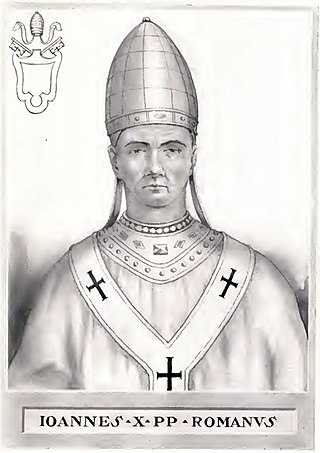The 900s decade ran from January 1, 900, to December 31, 909.
The 910s decade ran from January 1, 910, to December 31, 919.
The 920s decade ran from January 1, 920, to December 31, 929.
The 960s decade ran from January 1, 960, to December 31, 969.

Year 976 (CMLXXVI) was a leap year starting on Saturday of the Julian calendar.

Year 916 (CMXVI) was a leap year starting on Monday of the Julian calendar.

Year 914 (CMXIV) was a common year starting on Saturday of the Julian calendar.
This is an alphabetical index of people, places, things, and concepts related to or originating from the Byzantine Empire. Feel free to add more, and create missing pages. You can track changes to the articles included in this list from here.
The Battle of Devina occurred on 17 July 1279 near the small fortress of Devina, close to the modern town of Kotel, Burgas Province, south-eastern Bulgaria. Ivailo of Bulgaria attacked the Byzantine army sent to help his rival for the crown Ivan Asen III.
The Battle of Pegae was fought between 11 and 18 March 921 in the outskirts of Constantinople between the forces of the Bulgarian Empire and the Byzantine Empire during the Byzantine–Bulgarian war of 913–927. The battle took place in a locality called Pegae, named after the nearby Church of St. Mary of the Spring. The Byzantine lines collapsed at the very first Bulgarian attack and their commanders fled the battlefield. In the subsequent rout most Byzantine soldiers were killed by the sword, drowned or were captured.
The 1020s was a decade of the Julian Calendar which began on January 1, 1020, and ended on December 31, 1029.
The Battle of Strumica took place in August 1014, near Strumica, present-day North Macedonia, between Bulgarian and Byzantine forces. Bulgarian troops under Emperor Samuil's son Gavril Radomir defeated the army of the governor of Thessaloniki, Theophylactus Botaniates, who perished in the battle. After his death the Byzantine Emperor Basil II was forced to pull back from Bulgaria and was unable to take advantage of his success in the recent Battle of Kleidion.

The Battle of Setina took place in the autumn of 1017 near the village of Setina in modern northern Greece between the armies of the Bulgarian Empire and Byzantine Empire. The result was Byzantine victory.

Georgi Voyteh was an 11th-century Bulgarian aristocrat from Skopje who started a major uprising in Byzantine Bulgaria against the Byzantine rule.
Maria Palaiologina Kantakouzene was an Empress consort of Bulgaria by marriage to two Bulgarian emperors, Constantine Tikh and Ivaylo. She was a niece of Michael VIII Palaiologos.

The Treaty of 716 was an agreement between Bulgaria and the Byzantine Empire. It was signed by the son of the ruling Bulgarian Khan Tervel, Kormesiy and the Byzantine Emperor Theodosius III.
The Bulgarian–Serbian wars of 917–924 were a series of conflicts fought between the Bulgarian Empire and the Principality of Serbia as a part of the greater Byzantine–Bulgarian war of 913–927. After the Byzantine army was annihilated by the Bulgarians in the battle of Achelous, the Byzantine diplomacy incited the Principality of Serbia to attack Bulgaria from the west. The Bulgarians dealt with that threat and replaced the Serbian prince with a protégé of their own. In the following years the two empires competed for control over Serbia. In 924 the Serbs rose again, ambushed and defeated a small Bulgarian army. That turn of events provoked a major retaliatory campaign that ended with the annexation of Serbia in the end of the same year.
The Byzantine–Bulgarian war of 913–927 was fought between the Bulgarian Empire and the Byzantine Empire for more than a decade. Although the war was provoked by the Byzantine emperor Alexander's decision to discontinue paying an annual tribute to Bulgaria, the military and ideological initiative was held by Simeon I of Bulgaria, who demanded to be recognized as Tsar and made it clear that he aimed to conquer not only Constantinople but the rest of the Byzantine Empire, as well.
The siege of Constantinople was fought in June 922 at the outskirts of the capital of the Byzantine Empire, Constantinople, between the forces of the First Bulgarian Empire and the Byzantines during the Byzantine–Bulgarian war of 913–927. In the summer the Byzantine Emperor Romanos I Lekapenos sent troops under the commander Saktikios to repel another Bulgarian raid at the outskirts of the Byzantine capital. The Byzantines stormed the Bulgarian camp but were defeated when they confronted the main Bulgarian forces. During his flight from the battlefield Saktikios was mortally wounded and died the following night.






